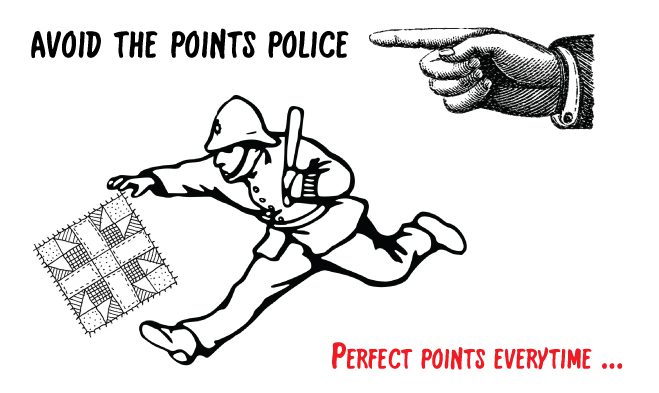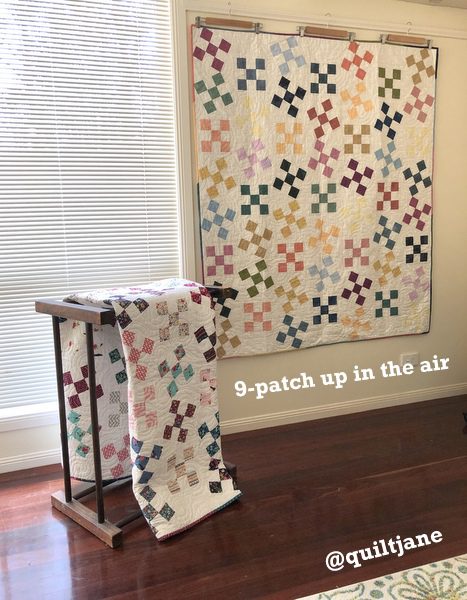
Matching points for all types of intersections.

There are so many wonderful quilt blocks that have an abundance of triangles and diamonds. Today I will share with you some tips on how to manage the seam intersections when piecing.
There are many steps involved in good piecing. These include:
1. Accuracy in cutting the pieces
2. Sharp machine needle (not blunt or damaged)
3. Good machine tension
4. Accurate and consistent seams
Today I will focus on 1 and 4.
No 1. – Accurately cutting the individual pieces will make it easy to match and pin pieces together. Whether it is a piece cut from fabric, such as a square or a piece (unit) made from a combination of pieces. For example, adding a triangle to a rectangle to make a corner triangle unit.
Units, like the corner triangle unit, can be tricky to join if the edge measurement of the triangle is not

No. 4 is very important. If seams are not consistent in width or tapper at the start and end of a piece, it makes it harder to match seams and gathering and puckering of the fabric can occur.

Let’s look at sewing a block together, consisting of 2 half square triangles and a rectangle.
If you are a beginner and a visual learner you can draw a pencil line or remove the thread from your machine needle and stitch on the seam lines to mark the seam line. This will give you an indication where seams should intersect.

Place the HST’s right sides together. (The HST’s should be trimmed to equal size). Nest the

Pin in place and stitch the seam. Press seams to one side (or open seams).
Tip, using a scrap of fabric as a leader helps make an accurate start to the piecing.

Next step is to add the rectangle. To secure the pieces using pins, look straight on at the 2 pieces. Place a pin through the intersecting stitch lines on the front piece and 1/4″ seam on the back piece.
Keeping that

Stitch block together, slowing down at seam intersection. The stitch line should be a needle width above the two intersecting seams so when you press the block the tip of the triangle is not cut off by the fold in the seam.


This simple introduction to managing seam intersections can be applied to any seams.
The back to school blog hop 2019 has been running all September. Visit the following sites to learn some great tips and tricks.
Day 1 – September 1 – Sam Hunter: Sewing Long Seams Without Stretching – huntersdesignstudio.com
Day 2 – September 2 – Susan Arnold – Joining Binding the Easy Way – quiltfabrication.com
Day 3 – September 3 – Angie Wilson – Fussy cutting tips and techniques – www.gnomeangel.com
Day 4 – September 4 – Andi Stanfield – No-Mark HST: Let your machine be your guide – truebluequilts.com/blog/
Day 5 – September 5 – Bobbie Gentili – Say YES to Y-seams – geekybobbin.com
Day 6 – September 6 – Mel Beach – 5 Reasons to Say Woo Hoo! to School Glue – pieceloveandhappiness.blogspot.com
Day 7 – September 7 – Laura Piland – 7 Ways to Use a Laser on Your Sewing Machine – www.sliceofpiquilts.com
Day 8 – September 8 – Suzy Webster – How to solve loops in free motion quilting – www.websterquilt.com
Day 9 – September 9 – Tara Miller – Accurate Stitch-and-Flip Corners – quiltdistrict.com
Day 10 – September 10 – Latifah Saafir – Accurate Seams Using Masking Tape! – latifahsaafirstudios.com
Day 11 – September 11 – Sarah Ruiz – The Magic of Glue Basting – saroy.net
Day 12 – September 12 – Jen Shaffer – Ways to stop your ruler from slipping while cutting – patternsbyjen.blogspot.com
Day 13 – September 13 – Cheryl Sleboda – Basics of ruching (a vintage fabric manipulation technique) – muppin.com
Day 14 – September 14 – Raylee Bielenberg – Choosing quilting designs for your quilt – www.sunflowerstitcheries.com
Day 15 – September 15 – Jen Strauser – Accurate and Attractive Machine binding – dizzyquilter.com
Day 16 – September 16 – Jane Davidson – Matching points for all types of intersections – quiltjane.com
Day 17 – September 17 – Teresa Coates – Starch and starch alternatives – teresacoates.com
Day 18 – September 18 – Jen Frost – Benefits of spray basting – faithandfabricdesign.com
Day 19 – September 19 – Sandra Starley – Getting started with Hand Quilting – utahquiltappraiser.blogspot.com
Day 20 – September 20 – Karen Platt – Drunkard’s Path Made Easy – karenplatt.co.uk/blog/
Day 21 – September 21 – Kris Driessen – All Kinds of Square (in a Square) – scrapdash.com
Day 22 – September 22 – Sarah Goer – Planned Improv Piecing – sarahgoerquilts.com
Day 23 – September 23 – Kathy Bruckman – Organizing kits for on-the-go sewing – kathyskwiltsandmore.blogspot.com
Day 24 – September 24 – Cheryl Daines Brown – The Secret to Flat Quilt Tops: Borders – quilterchic.com
Day 25 – September 25 – Cherry Guidry – Pre-assembling fusible applique – cherryblossomsquilting.com
Day 26 – September 26 – Laura Chaney – Getting started with English Paper Piecing – prairiesewnstudios.com
Day 27 – September 27 – Ebony Love – Cutting Bias Strips from a Rectangle – lovebugstudios.com
Day 28 – September 28 – Tammy Silvers – Working with heavier weight threads in your machine – tamarinis.typepad.com
Day 29 – September 29 – Kathy Nutley – Create a perfect facing or frame with 90 degree angles – quiltingsbykathy.com
Day 30 – September 3 – Joanne Harris – Using Leaders and Enders – quiltsbyjoanne.blogspot.com





One Comment
Virtual Quilter
To me you wrote the magic words … avoid trimming! Accurate cutting and stitching does not require any trimming! I watch so many people spending as much time trimming as they do cutting which is such a waste of time and effort.